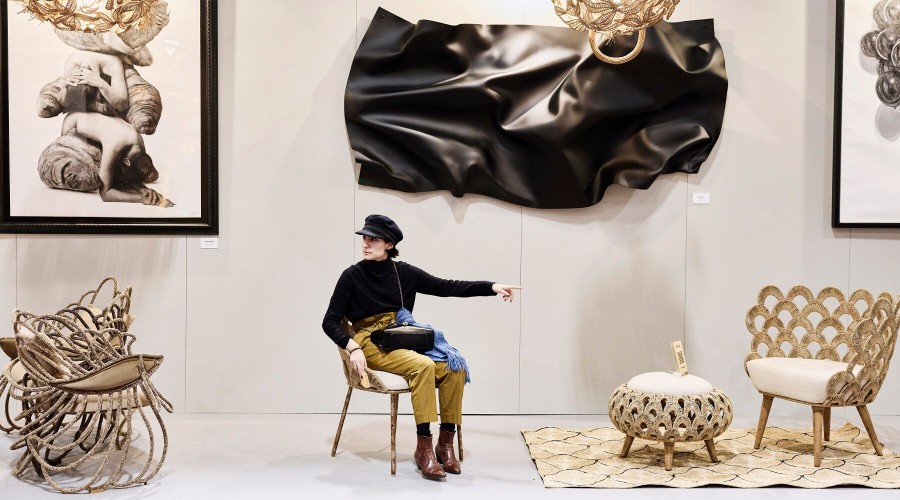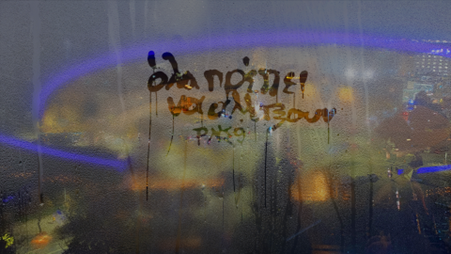“Alexandria: Past-Futures” στην Bozar
DS.WRITER:
Sophia Throuvala
Κεντρική Εικόνα: Aslı Çavuşoğlu, Gordian Knot (2013). Ceramic. 50 x 29 x 28 cm. Exhibition view: Alexandria: Past Futures, BOZAR – Centre for Fine Arts, Brussels (30 September 2022–8 January 2023). Πηγή εικόνας: e-flux.com
Με αφορμή την πρόσφατη ολοκλήρωση της έκθεσης Alexandria: Past Futures στην Bozar των Βρυξελλών, ξεκινά μια συζήτηση για τις πολλαπλές εκδοχές της Αλεξάνδρειας, μιας πόλης που τη χαρακτηρίζει μια πολύ συγκεκριμένη μυθολογία. Πρόκειται για μια ιδιαίτερη προσπάθεια ανάδειξης ρεαλιστικότερων αφηγηματικών εκδοχών της πόλης, ενώ παράλληλα εντυπωσιάζει ο τρόπος εξιστόρησης μέσα από την έξυπνη επιμέλεια και διαχείριση των πολλών και διαφορετικών εκθεμάτων. Στον χώρο, συν-εκτίθενται 17 σύγχρονα έργα τέχνης και πάνω από 200 αρχαιότητες από -και για- το Λιμάνι της Αλεξάνδρειας. Η συμπαράθεση και συνάμα αντιπαράθεση των εκθεμάτων, όπως άλλωστε δηλώνει και ο τίτλος Alexandria: Past Futures, έχουν ως στόχο να ερευνήσουν, παρουσιάσουν και επανερμηνεύσουν αυτό που σημαίνει σήμερα η λέξη “Αλεξάνδρεια”.
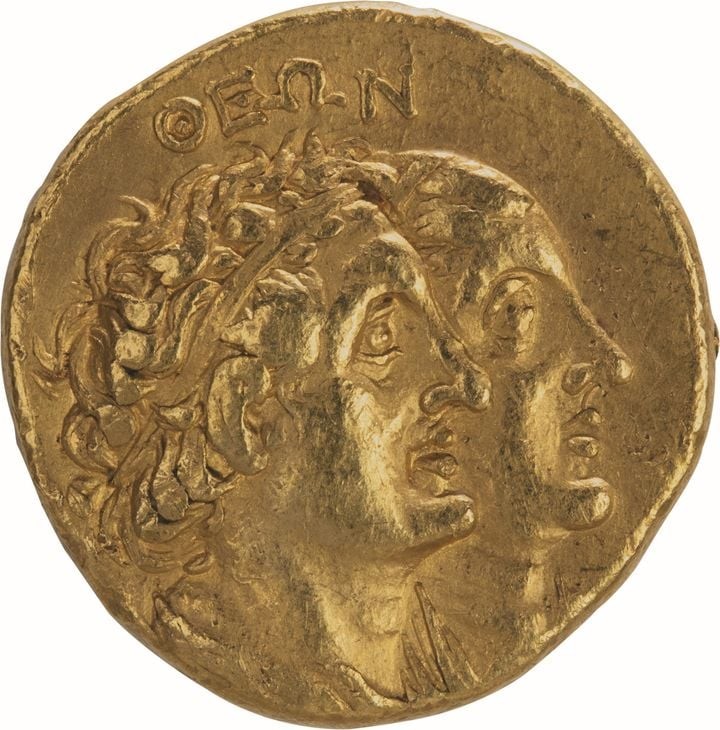
'Dynastic' tetradrachm, deified sovereigns, obverse: busts of Ptolemy II and Arsinoe II / reverse: busts of Ptolemy I and Berenice I (3rd century BC). Gold. Morlanwelz, Musée royal de Mariemont. Courtesy Musée royal de Mariemont.
Η έκθεση πιάνει το νήμα της αφήγησης από την εμβληματικότερη “τοπική” μορφή, τον Μέγα Αλέξανδρο. Στα πρώτα δωμάτια εμφανίζονται πολλές διαφορετικές εκδοχές του σε εκμαγεία και νομίσματα, κάνοντας αναφορά στη συνέπεια και ασυνέπεια της απεικόνισης μιας προσωπικότητας περισσότερο συμβολικής. Το πρόσωπό του αντιπαραβάλλεται με εκείνα του Ιουλίου και του Αυγούστου Καίσαρα σε έργα του 19ου αιώνα, κάνοντας αναφορά στη μη ευεργετική-ιδρυτική ιδιότητα του Αλεξάνδρου αλλά και σε εκείνη του κατακτητή. Στην ίδια αίθουσα, η καλλιτέχνις Asli Cavusoglu, βασισμένη σε μια προτομή του Αλεξάνδρου από τον 2ο αι π.Χ. και την προφητεία του Γόρδιου Δεσμού, προσπαθεί έξυπνα να ερμηνεύσει το σύγχρονο Μακεδονικό ζήτημα μεταξύ Ελλάδας και Βουλγαρίας, σπάζοντας το εκμαγείο στη μέση και διχοτομώντας έτσι τον Αλέξανδρο σε δύο μισά, σύμβολο της διεκδίκησής του από τα δύο κράτη.
 αντίγραφο.jpg)
Hrair Sarkissian, Background (2015). C-print. Courtesy © Hrair Sarkissian. Exhibition view: Alexandria: Past Futures, BOZAR – Centre for Fine Arts, Brussels (30 September 2022–8 January 2023). Πηγή εικόνας: e-flux.com
Ο Hrair Sarkissian, στο έργο “background”, θέτει το ερώτημα περι μνημείου, συμβόλου και αρχειακής τεκμηρίωσης. Εκθέτει αρχαία αρχιτεκτονικά μέλη, φωτογραφημένα σαν να πρόκειται για ευρήματα που θα καταχωρηθούν σε αρχειακή συλλογή. Ως, δηλαδή, ένα ντοκουμέντο που πρόκειται να μελετηθεί περαιτέρω, πάντα όμως από την πλευρά της ιστορίας που εξυπηρετεί τον μύθο. Στον ίδιο χώρο εκτίθεται μια φωτογραφία υψηλής ανάλυσης ενός ρωμαϊκού ψηφιδωτού, η οποία τονίζει ακριβώς το φαινόμενο της “κατασκευής” και της εγγεγραμμένης ερμηνείας στα αρχαιολογικά ευρήματα.
Στην αίθουσα με τους χάρτες της Αλεξάνδρειας (16ος - 20ός αι.), παρουσιάζεται η μυθοποιημένη Αλεξάνδρεια της Αρχαιότητας, η Αλεξάνδρεια των τουριστών, η Αλεξάνδρεια που η μορφή της βασίζεται σε αφηγήσεις. Εδώ, το σύμβολο του Φάρου, γεωγραφικού σήματος απαραίτητου για τη μυθική αποκατάσταση της εικόνας της αρχαίας πόλης και ενός από τα 7 θαύματα της αρχαιότητας, επανεξετάζεται μέσα από τα έργα “Gorgon-avt” της Jasmina Metwaly και “Restored Again” της Ellie Ga. Η τελευταία, προσπαθώντας να οργανώσει μια μελέτη γύρω από την αρχιτεκτονική του μυθικού μνημείου, παρουσιάζει σειρά 160 φωτογραφιών. Μία εξ αυτών είναι η ψηφιοποιημένη εκδοχή ενός χειρογράφου του 16ου αιώνα (folio 17v 2168, Bibliothèque nationale de France, Paris), το οποίο παρουσιάζεται και αυτούσιο σε προθήκη στον ίδιο χώρο, ανοιγμένο στην ίδια ακριβώς σελίδα. Η επιμελητική αυτή επιλογή των Edwin Nasr και Sarah Rifky, εμπλέκει το σύγχρονο με το ιστορικό και δεξιοτεχνώς την αρχαιογνωστική με την εικαστική αφήγηση της ιστορίας της πόλης. Ίσως πρόκειται για το μόνο σημείο σύγκλισης των δυο αφηγήσεων σε ολόκληρη την έκθεση.
 αντίγραφο 2.jpg)
Lighthouse of Alexandria, in Muhammad ibn'Abdal-Rahim Al-Qaysi, Tuhfat al-Albâb, Cadeau offert aux hommes intelligents et choix de merveilles, folio 17v (16th century). Manuscript. Courtesy Department of Manuscripts, mission orientale arabe 2168, Bibliothèque nationale de France, Paris.
Η κριτική στην αποικιακή πρόσληψη της Αλεξάνδρειας ως τόπου μυθικού, ως χώρου συνάντησης των τεχνών και του πολιτισμού, και κυρίως ως μιας πόλης που εξελληνίστηκε και “σώθηκε”, αποτελεί κεντρικό διακύβευμα της έκθεσης. Το πολύτιμο ελληνικό και ρωμαϊκό στίγμα ετεροκαθορίζει αιώνες την Αίγυπτο, το Πακιστάν και τη Συρία, τόπους που είναι “τυχεροί” να “φιλοξενούν” ελληνιστικά και ρωμαϊκά μνημεία που προσελκύουν τον τουρισμό και αναπτύσσουν την οικονομία. Η Alexandria: Past Futures απαντά κριτικά στα παραπάνω ζητήματα καθ’ όλη την έκθεση, ωστόσο δύο έργα θα μπορούσαν να χαρακτηριστούν τα περισσότερο σαφή. Η συμπαράθεση ενός ειδωλίου του 30 π.Χ. από τερακότα, το οποίο απεικονίζει την Ίσιδα να θηλάζει τον γιο της Ώρο, και μιας εικόνας της Γαλακτοφόρου Παναγίας, που ουσιαστικά οικειοποιείται τον απεικονιστικό τύπο της Ίσιδας, τονίζει την αμφίδρομη και όχι μονόπλευρη σχέση επιρροής μέσα από σύμβολα και εικόνες.
Το έργο “Water Arm” της Jumana Manna, κάνει κι αυτό αναφορά στην αποικιακή πρόσληψη της Αλεξάνδρειας, μέσα από την κριτική στο gentrification των περιοχών που φιλοξενούν τουρίστες. Παρουσιάζοντας μια εγκατάσταση απαρτιζόμενη από παλιούς σωλήνες ύδρευσης και αποχέτευσης, η καλλιτέχνις τονίζει τον επιφανειακό και βεβιασμένο εκσυγχρονισμό της Αλεξάνδρειας και άλλων αντίστοιχων πόλεων, των οποίων οι υποδομές και οι συνθήκες διαβίωσης των κατοίκων διαφέρουν σημαντικά από εκείνες των επισκεπτών της, αναδεικνύοντας έτσι πως, το χρήμα που προέρχεται από τον τουρισμό, ανακυκλώνεται χωρίς τελικά να λύνει κανένα από τα πρακτικά ζητήματα.
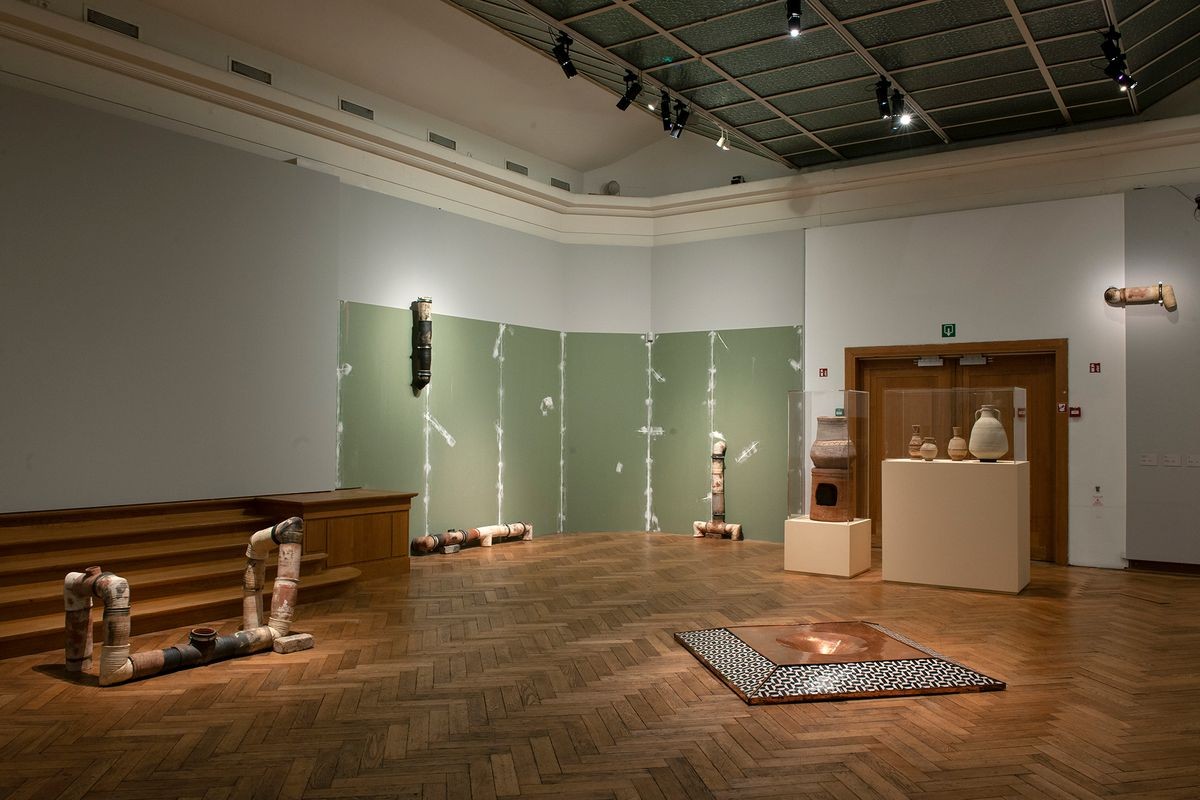
Ellie Ga, It Was Restored Again (2013). Slide installation. Courtesy the artist and Bureau, New York. Exhibition view: Alexandria: Past Futures, BOZAR – Centre for Fine Arts, Brussels (30 September 2022–8 January 2023). Photo: © Philippe De Gobert.
Ένα τέτοιο παράδειγμα είναι η νέα Βιβλιοθήκη της Αλεξάνδρειας, ένα έργο κολοσσιαίο, που εξυπηρετεί την ανάγκη της αναβίωσης του μυθικού χώρου και όχι τη σωτηρία του πραγματικού. Η έκθεση Alexandria: Past Futures συζητά ανοιχτά, για πρώτη φορά σε αυτή τη μορφή, το ζήτημα της πρόσληψης της θεμελιωμένης πραγματικότητας, η οποία όμως περιεχομενικά δεν είναι παρά μια σειρά φανταστικών εκδοχών μιας καθ’ όλα σύγχρονης και όχι αρχαίας πόλης.
.jpeg)
Νέα βιβλιοθήκη της Αλεξάνδρειας, 2019
Το έργο στο τελευταίο δωμάτιο είναι η εμβληματική βιντεο-εγκατάσταση, με τίτλο “Isles of the Blessed (Oops!...I forgot Europe)”, του Αλεξανδρινού καλλιτέχνη και ερευνητή Wael Shawky. Η σημασία του συγκεκριμένου έργου και της τοποθέτησής του στο τέλος της έκθεσης είναι προφανής. Το έργο λειτουργεί σαν κατακλείδα των όσων πραγματεύεται ολόκληρη η επιμελητική πρόταση, θέτοντας το ερώτημα: μας ενδιαφέρει η πατρότητα των καταστατικών μύθων της Ευρώπης; Αν ναι, ο καλλιτέχνης είναι έτοιμος να απαντήσει πως ο αρχαίος μύθος θέλει την Ευρώπη, ομώνυμη πριγκίπισσα, να κατάγεται από τον σημερινό Λίβανο. Παράλληλα, ο αδελφός της, Κάδμος, είναι αυτός που, παίρνοντας το αλφάβητο από τους Φοίνικες και χαρίζοντάς το στους Έλληνες, τους έδωσε τη δυνατότητα να αναπτυχθούν ως το λίκνο του ευρωπαϊκού πολιτισμού. Με το έργο αυτό, δεν θέλει να διεκδικήσει πράγματι την πιθανολογούμενη εξ ανατολάς προέλευση της θρησκείας και της γλώσσας των Ελλήνων, αλλά να τονίσει τη ρευστότητα των γεωγραφικών ορίων και των ιστορικών όρων, έναντι του δογματισμού που προάγει την παρερμήνευση της ιστορίας, και τον κατ’ εξακολούθηση ετεροκαθορισμό και φετιχοποίηση της Αιγύπτου από τη Δύση.
Η έκθεση συνεχίζει το ταξίδι της στο Mucem της Μασσαλίας, από τις 8 Φλεβάρη ως τις 8 Μαΐου.
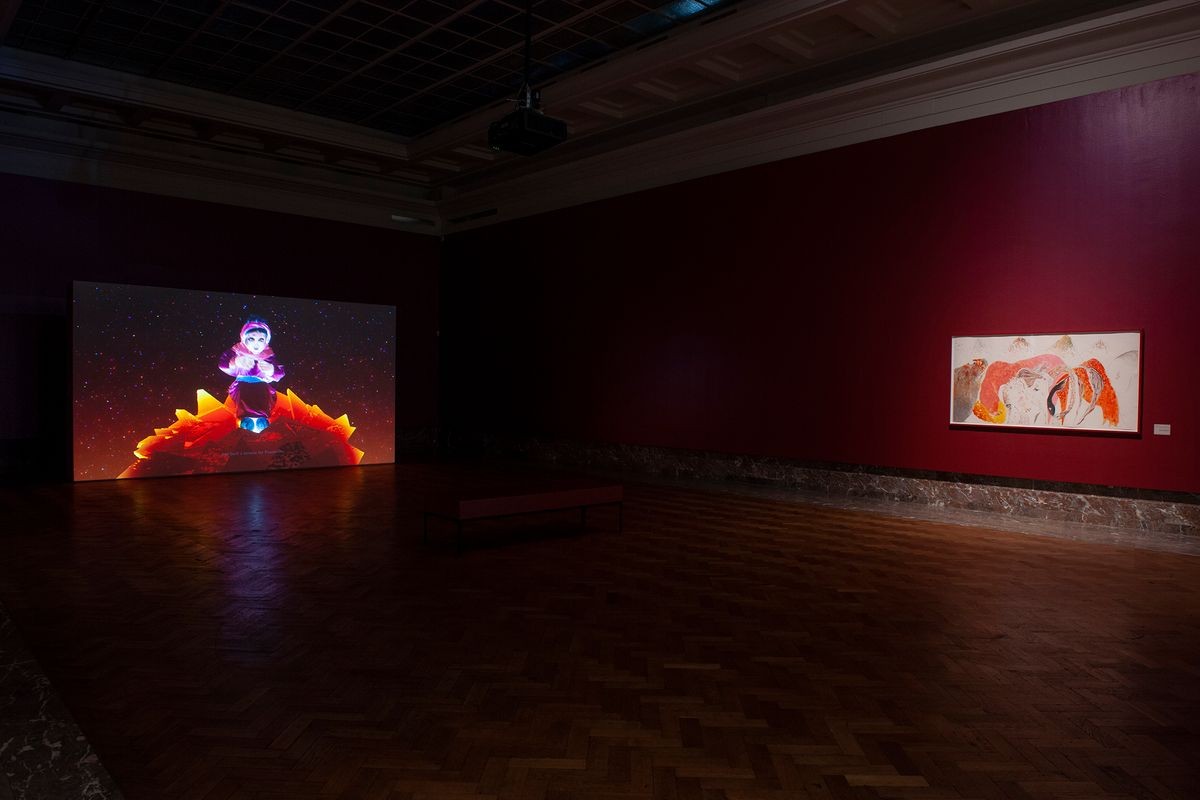




.jpg)
.jpg)
.jpg)
